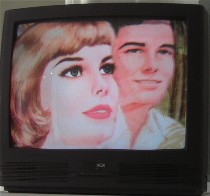 Just a few days left to the election and even fewer for this month’s group of exhibits at Vox Populi, up until the 31st.
Just a few days left to the election and even fewer for this month’s group of exhibits at Vox Populi, up until the 31st.
An examination of what’s real and what’s ideal (that’s the Platonic point) seems to be on the minds of everyone showing there.
Robert Arnold in the Video Lounge offered up several short films and videos, of which I saw three. One of them was the perfect, ideal romantic kiss. (I could really confuse things here and call it Platonic but that would confuse everyone, because the coupling here was anything but Platonic in that other sense). “The Morphology of Desire” (image, top), from 1998 was laugh-out-loud funny, with borrowed images of American-brand idealized men and women from romance magazines and bookcovers morphing to create a rhythmic sexual coupling, starting with longing looks and climaxing in pulsating motions, all to a heartbeat soundtrack. These particular “ideals” have been manipulated to undermine themselves.
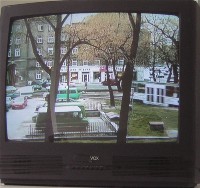 In “Triptych” (image left) an urban scene is divided in three by two tall trees that perform as stage doors through which trains or cars sometimes appear and disappear. Even night falls unevenly across the triptych.
In “Triptych” (image left) an urban scene is divided in three by two tall trees that perform as stage doors through which trains or cars sometimes appear and disappear. Even night falls unevenly across the triptych.
“Echolalia” (2003) offers television-screen captures of politicians and pundits saying the words weapons of mass destruction (with some variant versions like biological weapons), thereby revealing the power of the repetition to create fear. Although W, who talks to God when he makes his decisions, was the star of this one, he was not alone. Even the liberal Sen. Joseph Biden made an appearance (since he’s a regular on the TV news talk shows). The name of the film is of course a term straight out of the fundamentalist, Bible-thumping culture of speaking in tongues. We’re witnesses here to a national, media-generated self-delusion.
Arnold, an associate professor of film at Boston University and a visiting professor at Poznan Academy of Fine Arts in Poland, has won a number of awards for his videos. Check them out.
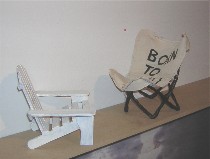 And while I’m on the subject of politics, Isaac Resnikoff‘s “Born to Kill” examines politics, art and American values. Resnikoff, who is a sweet fellow who definitely was not Born to Kill, has a killer sense of humor that had me chuckling my way through his roughly crafted show of anti-objets from the American dream (image right, “Seating Solutions for the Conflicted,” the miniature Adirondack chair emblazoned with Idle Hands, the butterfly chair with Born to Kill).
And while I’m on the subject of politics, Isaac Resnikoff‘s “Born to Kill” examines politics, art and American values. Resnikoff, who is a sweet fellow who definitely was not Born to Kill, has a killer sense of humor that had me chuckling my way through his roughly crafted show of anti-objets from the American dream (image right, “Seating Solutions for the Conflicted,” the miniature Adirondack chair emblazoned with Idle Hands, the butterfly chair with Born to Kill).
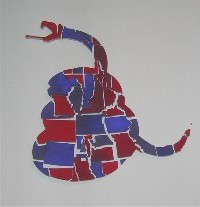 His “Electoral College Mascot” (left) is a bug-shaped map of red and blue puzzle pieces that passes for a heart (not quite Bo Bartlett’s Heartland, is it?) and is based on the Don’t Tread on Me snake. “Idle Hands (Endless Night)” is a cheesy, wall-paneling version of Brancusi’s endless column with an ashtray on top, filled with faux cigarettes (right). It’s the all-too-material version of Brancusi’s sculptural ideal.
His “Electoral College Mascot” (left) is a bug-shaped map of red and blue puzzle pieces that passes for a heart (not quite Bo Bartlett’s Heartland, is it?) and is based on the Don’t Tread on Me snake. “Idle Hands (Endless Night)” is a cheesy, wall-paneling version of Brancusi’s endless column with an ashtray on top, filled with faux cigarettes (right). It’s the all-too-material version of Brancusi’s sculptural ideal.
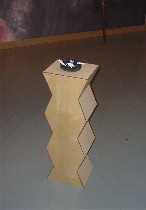 The materials in this show–a lot of plywood, Sculpey, roughly applied gouache, words embroidered off center on pillows, wooden sculptures of tools that were carved with a kitchen knife–all bring into question sculpture and the material world in general, and most of all, Americana and the questionable, unspoken Platonic values implied beneath the material (and verbal) culture. Although a little uneven, this is a show worth a visit.
The materials in this show–a lot of plywood, Sculpey, roughly applied gouache, words embroidered off center on pillows, wooden sculptures of tools that were carved with a kitchen knife–all bring into question sculpture and the material world in general, and most of all, Americana and the questionable, unspoken Platonic values implied beneath the material (and verbal) culture. Although a little uneven, this is a show worth a visit.
As an aside, Resnikoff, who was gallery sitting when I arrived, mentioned to me that his grandmother had agreed to crochet pillow covers for him, but then she couldn’t bring herself to put the words Born to Kill on them. The project ground to a halt. So Resnikoff improvised with a pair of Early American style pillows embroidered, one with Born to Kill, the other with Idle Hands (the words are everywhere). (Am I right to assume that “Idle hands are the devil’s tools” is an expression everyone is familiar with? I never know how far into the next generation expressions like that travel. Clearly, the words reached Resnikoff.)
 By the way, Resnikoff has work that opened Oct. 23 in New York at Rivington Arms, 102 Rivington St. on the Lower East Side.
By the way, Resnikoff has work that opened Oct. 23 in New York at Rivington Arms, 102 Rivington St. on the Lower East Side.
Nami Yamamoto‘s “tidal,” an undulating, wall-to-wall floor cloth, covers the front room gallery floor (installation shot left). The gray cloth is printed with stylized white wave and water motifs from 17th century Japanese paintings–perfect waves printed on perfect waves. Platonic and elegant.
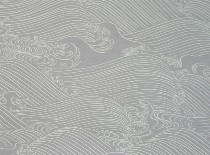 Though it’s a floor cloth, it’s too delicate and carefully arranged to give us a chance to walk on the water. Without more visual va-va-voom, I’m looking for some more meaning, but I’m coming up dry (detail, right).
Though it’s a floor cloth, it’s too delicate and carefully arranged to give us a chance to walk on the water. Without more visual va-va-voom, I’m looking for some more meaning, but I’m coming up dry (detail, right).
The other exhibit is video artist Nadia Hironaka’s three-screen video installation, “A Girl Named Prism.” I’ve always been a fan, but this one was such a challenge for me that after sitting and sitting and sitting, I bolted (installation shot left).
 Starring performance artist Martha McDonald, the videos tell the story of one woman struggling to create perfect sync between her past, present and future selves–a kind of struggle to reach some Platonic ideal that the material world in real life never can get to. I’m not even sure in what sense past, present and future can ever be in sync or what in sync means in this context.
Starring performance artist Martha McDonald, the videos tell the story of one woman struggling to create perfect sync between her past, present and future selves–a kind of struggle to reach some Platonic ideal that the material world in real life never can get to. I’m not even sure in what sense past, present and future can ever be in sync or what in sync means in this context.
Of what I saw, the film was great to look at, the colors practically radioactive. Motifs like gemstones, colored blouses, screens drenched in color, private life, work life, sex life, motherhood, cuts of raw meat, cycled through the videos offering a rhythmic eye candy. As always, Hironaka offered a sense of spaces and what they mean–rooms, offices, streets, doors. The sounds were of ambient noises like car horns, and the conversations were too low to be understood. But my mind couldn’t wrap around the time warps and ultimately my impatience won the day.









